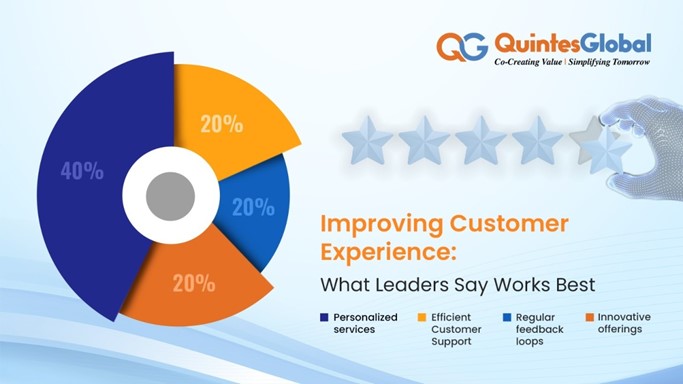
Customer experience (CX) has always been at the heart of business success. But what strategies truly make the most impact? We recently posed this question to business leaders in a poll: “What is the most effective way to improve customer experience, and why does it work for you? “
Let us dive into each response and explore how companies are successfully applying these strategies to enhance their customer experience.
- Personalized Services
Topping the list with the whopping 40% in favour, personalized services were the most cited factor, agreeing that customization is key to improving CX. This shouldn’t come as a surprise—today’s customers expect more than just a one-size-fits-all approach. They want businesses to understand their unique needs and offer solutions tailored specifically to them.
A case in example is Netflix. By leveraging data analytics and AI, Netflix creates highly personalized content recommendations for each user. The platform continuously tracks viewing habits, ratings, and preferences to fine-tune its recommendations, ensuring that users are more likely to find shows and movies they enjoy. This not only enhances customer satisfaction but also increases engagement and retention.
Similarly, Amazon uses customer data to deliver a personalized shopping experience, offering suggestions based on browsing history, past purchases, and even items in the shopping cart. This high level of personalization has been a major factor in Amazon's continued dominance in the e-commerce space.
For companies looking to enhance CX, personalized services can significantly boost customer loyalty and satisfaction by making every interaction feel uniquely catered to each individual. The challenge is, how to achieve CX that’s beyond expectations.
- Efficient Customer Support
Customer support is often the first line of defence when things go wrong, so it is no wonder that 20% of respondents emphasized the importance of efficient customer support in improving customer experience. It is also crucial to achieve CX goals. Prompt, knowledgeable, and effective service can turn a negative experience into a positive one, building trust and long-term customer relationships.
HubSpot made efficient customer support a central part of its business model. By offering 24/7 live chat support and an extensive self-help knowledge base, HubSpot ensures that customers can get the help they need, when they need it. Their focus on efficient support has earned them a loyal customer base and consistently high satisfaction ratings.
Efficient customer support shows that your company values customers' time and can solve their problems quickly—a cornerstone of great CX. AI in this space is being leveraged today with mixed customer response. Do you know a way to make it foolproof?
- Regular Feedback Loops
20% of leaders highlighted the importance of regular feedback loops to continually improve the customer experience. Businesses that actively seek out and respond to customer feedback can identify pain points and areas for improvement, which leads to better products and services over time.
A shining example of feedback loops at work is Quintes Global, the business process transformation company that offers end-to-end transformative solutions and services that impacts the end user and hence the business growth . Quintes Global uses customer feedback to drive innovative transformations. This customer-centric approach has helped #QG achieve 80+ NPS score and grow into one of the most respected ‘Global New Age Tier 1 Partner’ for enterprise services.
Similarly, Starbucks has a long history of using customer feedback to shape its offerings. Through its "My Starbucks Idea" platform, the company invited customers to share suggestions and vote on their favourites. Many ideas from this platform, such as free Wi-Fi and specific drink customizations, were implemented based directly on customer feedback.
By consistently collecting and acting on customer input, businesses can ensure that they are not just guessing what customers want—they know it.
- Innovative Offerings
Rounding out the poll, another 20% of leaders pointed to innovative offerings as a crucial way to enhance customer experience. Staying ahead of the curve with new, creative products and services can differentiate a company and keep customers excited about the brand.
A prime example of innovation in customer experience is Apple. Apple’s approach to innovation is not only about creating cutting-edge products but also about enhancing how customers interact with those products. From the seamless integration of hardware and software to the iconic Apple Store experience, Apple consistently redefines what customers expect from technology companies.
Tesla revolutionized the automotive industry by offering electric vehicles (EVs) that provide both performance and sustainability. Tesla’s constant push to innovate, from over-the-air software updates to self-driving features, has set new benchmarks for customer experience in the auto industry.
Innovation does help to keep customers engaged, providing them with fresh, exciting experiences that build brand loyalty and satisfaction.
Conclusion: A Balanced Approach to Customer Experience
What is clear from the poll is that there is no one-size-fits-all solution to improving customer experience. Personalized services are highly effective, but without efficient customer support, regular feedback loops, and innovative offerings, the CX score will remain negative. In fact, the most successful companies often adopt a combination of these strategies to create a well-rounded and superior customer experience.
Listening to your customers and adapting your strategies to meet their evolving expectations, goes a long way in achieving high CX. Whether it's through personalized engagement, proactive support, continuous feedback, or breakthrough innovation, the goal should always be to make customers feel valued and understood.
A question to consider for Enterprise Function Leaders:
How are you integrating personalization, support efficiency, feedback, and innovation into your customer experience strategy? Which of these factors do you believe can easily result from the existing business data?
